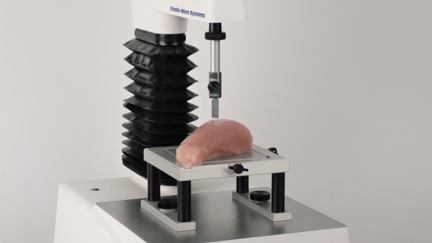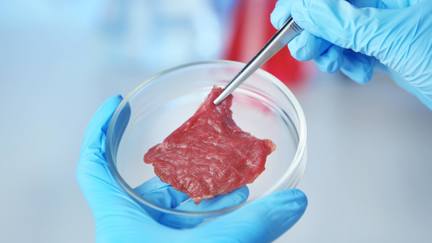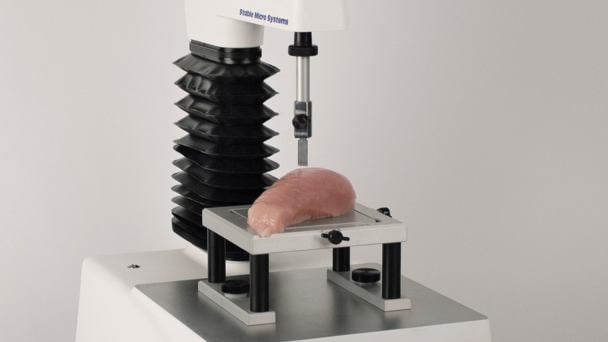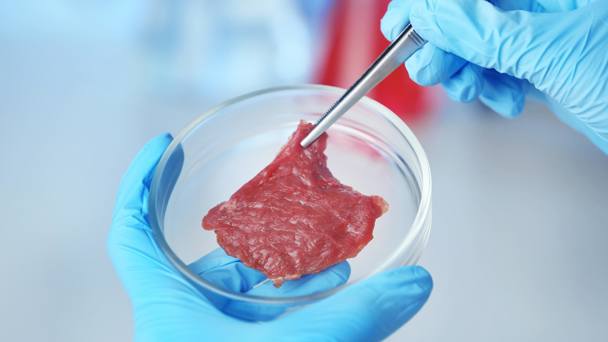
Meat products: The application of texture analysis on the latest developments
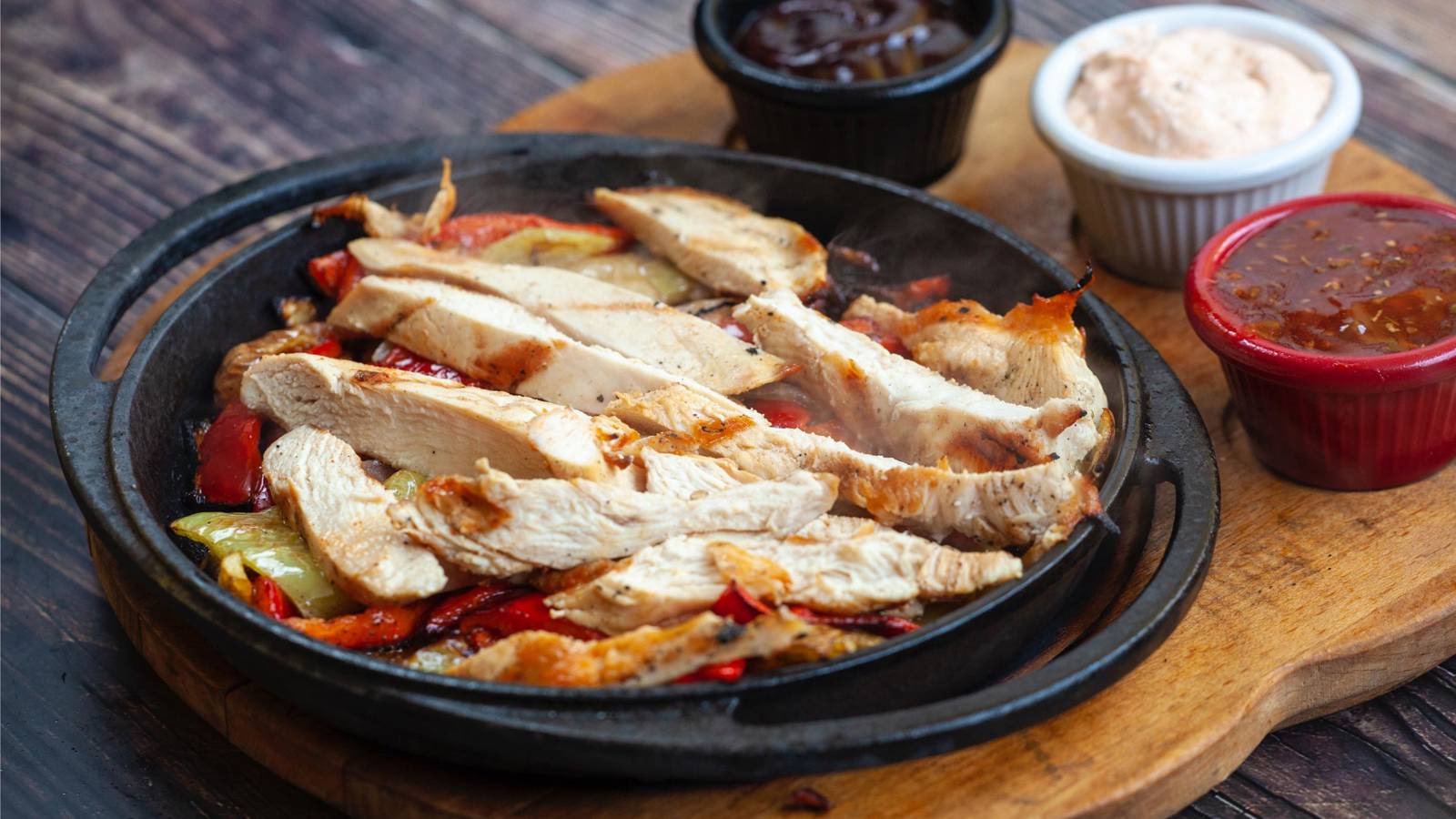
There are a number of developments in this field where texture analysis is already being applied. As with any manufacturing innovation, a large amount of research takes place during development, and the end product must go through a quality control process to assess its physical properties.
Whether its ensuring muscle myopathy is managed in poultry, new fat replacers are found for meat products, fermentation at mini-scale is made more economical, chicken meat is optimised for 3D printing or how shitake by-products can enhance low-salt burgers, the correct texture measurement is required to ensure product expectations are met.
A large amount of research is being carried out in the creation of meat alternatives in the quest to:
- Find new alternative proteins that are more sustainable and meet the need for growing protein demands
- Find uses for our food by-products
- Find cleaner, greener and less cruel methods of producing meat/fish
All of the above will desire the ‘same-as’ sensory experience. This is where you take a Texture Analyser to measure the ‘real’ meat and use it as the gold standard for alternative ‘meat’ developments. Without the measurement of texture you would otherwise have no objective means of knowing whether your new developments have reached their textural target.
What are the new ingredient and product ideas in meat and meat product research, development and production and how can a Texture Analyser be applied?
The meat and meat product industry is another segment that has seen significant innovations and changes. Here are some of the newer ingredient and product ideas in meat and meat product research, development, and production and a typical academic reference to show how the Texture Analyser has already being applied:
- Alternative proteins: This is perhaps the most significant trend, with plant-based meat substitutes from companies like Beyond Meat and Impossible Foods becoming increasingly popular. Other sources include fungi-based proteins, and even lab-grown meats are being developed.
Example: Meat Substitute Development from Fungal Protein (Aspergillus oryzae) - Reduced sodium and natural preservatives: With health concerns linked to high sodium intake and synthetic preservatives, there's a push for using natural preservatives such as rosemary or green tea extract and reduced sodium in processed meats.
Example: The application of pulsed electric field as a sodium reducing strategy for meat products - Functional meats: Enriching meat products with functional ingredients such as omega-3 fatty acids, vitamins, and minerals.
Example: Lasalocid-supplemented diets for improving carcass characteristics, meat quality, and fatty acids content of goats - Health-conscious products: Reduced fat, lean cuts, or products specifically formulated for certain dietary needs or health conditions.
Example: Effect of Pork Back Fat Replacement with Inulin Gel and Oat Bran Flour on the Physicochemical and Sensory Evaluation of a Leberkäse Meat Product - Lab-grown meat products: Lab-grown or cell-based meat is in development. It's produced by cultivating meat cells in a lab setting, resulting in meat products that don’t require large-scale animal husbandry.
Example: Artificial steak: A 3D printable hydrogel composed of egg albumen, pea protein, gellan gum, sodium alginate and rice mill by-products - Clean label movement: A push for simpler ingredient lists, free from synthetic chemicals and unnecessary additives.
Example: The effect of climatic conditions on the quality of medium-growth chicken meat in organic production systems - 3D printed meat products: Using 3D printing technology to create meat cuts or products with desired textures and shapes, potentially using cell-based meat or alternative proteins.
Example: Physico-chemical and Textural Properties of 3D Printed Plant-based and Hybrid Soft Meat Analogs - Ethical and sustainable sourcing: Grass-fed, free-range, and organic meat products are in demand due to concerns over animal welfare and environmental impact.
Example: Forage based diet as an alternative to a high concentrate diet for finishing young bulls - Effects on growth performance, greenhouse gas emissions and meat quality - Novel flavour profiles: Incorporating global and ethnic flavours into meat products.
Example: Effect of incorporation of pomegranate peel and bagasse powder and their extracts on quality characteristics of chicken meat patties - Customisable meat blends: Offering consumers the ability to customise their meat blends with specific cuts, fats, or even plant-based mix-ins.
Example: Consumer perception of snack sausages enriched with umami-tasting meat protein hydrolysates - High pressure processing (HPP): Using high pressure instead of heat to preserve meat, which can enhance its texture and flavour while killing pathogens.
Example: High-pressure processing and sous-vide cooking effects on physicochemical properties of meat-based, plant-based and hybrid patties - Utilising by-products: Making use of animal skins, bones, and offal to create value-added products, supplements, or as ingredients in other foods.
Example: Enhanced gelling performance of oxhide gelatin prepared from cowhide scrap by high pressure‐assisted extraction - Sous-vide and ready-to-eat meats: Gourmet quality, pre-cooked meats that can be quickly reheated and served, offering convenience without compromising on quality.
Example: The effect of extended refrigerated storage on the physicochemical, structural, and microbial quality of sous vide cooked biceps femoris treated with ginger powder (zingibain) - Alternative curing agents: Nitrate/nitrite replacements like celery juice powder for cured meats to address health concerns associated with synthetic nitrates/nitrites.
Example: Effects of natural nitrite source from Swiss chard on quality characteristics of cured pork loin
Using a Texture Analyser in meat and meat product development
The application of the Texture Analyser in meat product research and development encompasses a range of crucial dimensions in the meat industry in order to ensure product consistency and quality. In the pursuit of meat quality enhancement, this technology holds significant value.
Tenderness, a highly desirable attribute, especially in steaks, can be objectively quantified through using a Texture Analyser.
For products like sausages or processed meats, it assesses bite and chewiness by measuring the force required for consumption.
In processed meats, which often incorporate fillers and binders forming gels, the Texture Analyser can determine gel strength and characteristics. The binding and cohesiveness of meat particles, vital for items like meatballs or patties, are effectively gauged. Adhesiveness, particularly relevant for spreads or pâtés, is assessed to understand how the product behaves when spread on surfaces.
This technology's utility extends to quality control, ensuring consistent texture throughout meat batches, while also enabling the exploration of the impact of various processing conditions such as cooking methods and marination techniques.
In formulation testing, the Texture Analyser proves invaluable when introducing new ingredients or altering ratios, providing insights into the resultant texture changes. The Texture Analyser also supports comparative analysis, facilitating the comparison of meat substitutes with traditional meats and aiding in the formulation of products that closely mimic real meat. Furthermore, the Texture Analyser aids in shelf-life studies, monitoring textural changes that processed meats might undergo over time.
In the realm of meat product R&D, the Texture Analyser emerges as a critical tool, enabling informed decisions and facilitating the creation of meat products that meet consumer expectations and market demands.
The integration of innovative ingredients, sustainable practices, and tools like Texture Analysers ensures that the meat industry aligns with consumer demands while maintaining product quality and consistency.




